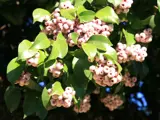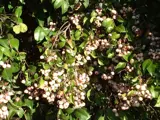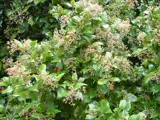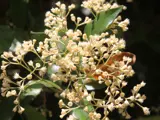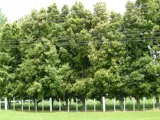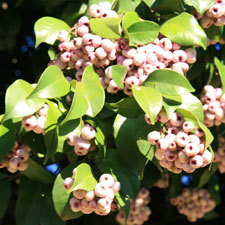 Monkey apple
Monkey apple
Common name: Monkey apple; Lilly Pilly
Botanical name: Syzygium smithii
Management category: Sustained control - Rule 5a applies
Originally from Australia. Introduced to New Zealand as an ornamental species and was recorded as naturalised in 1982.
Why is it a pest?
- Long-lived (100+ yrs) and produces a lot of seed.
- Bird spread (especially pigeons) so can disperse widely.
- Grows much faster than native species and invades gaps in the bush canopy.
- Forms a dense carpet of seedlings under canopy which flourish when gaps in the canopy are created.
- Can become a permanent canopy species and form almost pure stands.
- Tolerates most soil conditions and low light.
Where is it found?
Disturbed (occasionally intact) forests, shrublands, fernlands, often under pigeon roosts.
What does it look like?
- An evergreen tree (up to 15m tall) with smooth bark and oval, leathery leaves which are in opposite pairs along stems.
- Leaves are glossy on top and dotted underneath, and are very aromatic when crushed and often become scaly.
- Whitish flowers (from October to January) are followed by bunches of pink-mauve or white berry-like fruit with large seeds.
What are the rules?
Sustained control
Sustained Control pests are well established in the region and preventing the spread is no longer a realistic objective. Management focuses on reducing general impacts of the pest. Landowners/occupiers are responsible for the control of these pest species on their land. Council may enforce control.
Under rule 5a of the RPMP landowners/occupiers must destroy this pest if required by a written direction from an authorised person unless a property specific pest management agreement has been agreed and signed between the occupier and the Council.
Criteria to meet Rule 5A include when the species is being actively managed by council, other agency and or community group, on an adjacent property. See the Regional Pest Management Plan 2020-2030 rules for Sustained control pests for more information.
How do you get rid of it?
- Hand-pull (all year) – ensure roots are exposed.
- Dig out (all year) – ensure roots are exposed.
- Cut and paint (all year) stump with herbicide
- Frilling (all year)
- Spraying (spring to autumn)
CAUTION: When using any herbicide or pesticide, PLEASE READ THE LABEL THOROUGHLY to ensure that all instructions and directions for the purchase, use and storage of the product, are followed and adhered to.
Read more on pest control advice, information and regulations
Images

